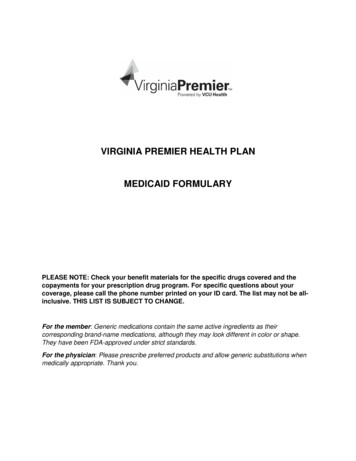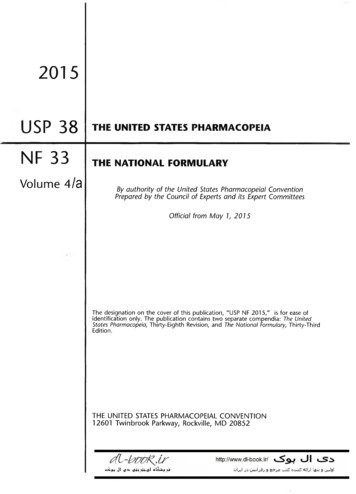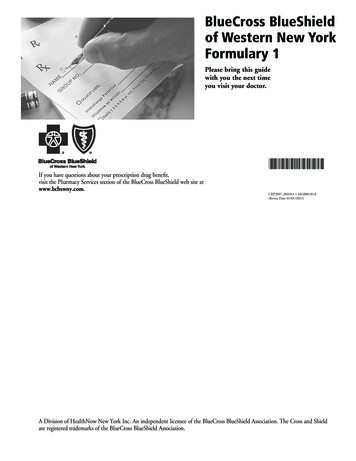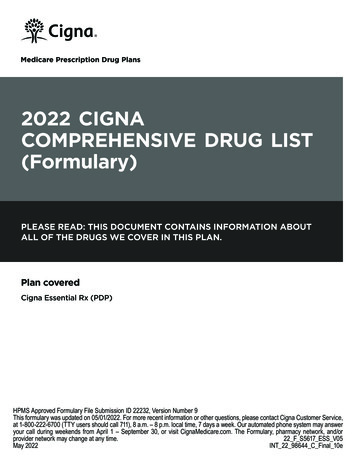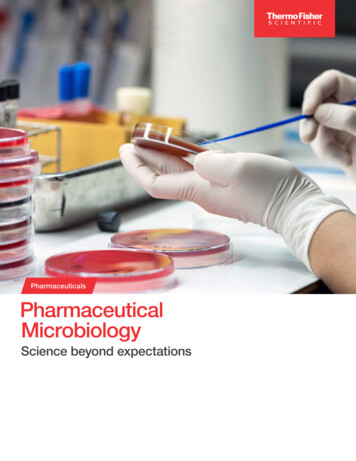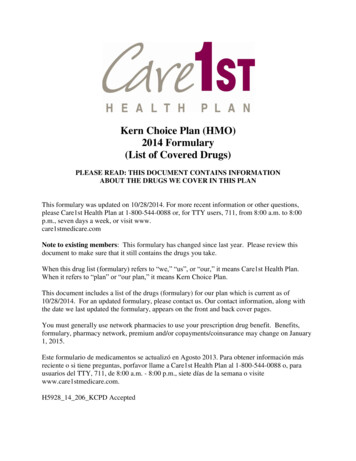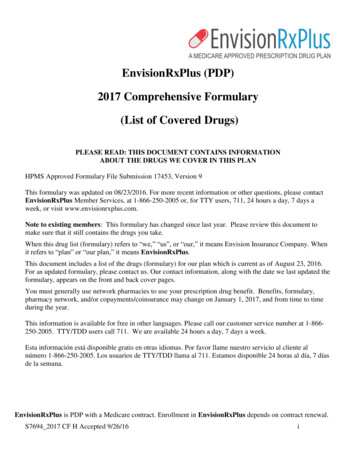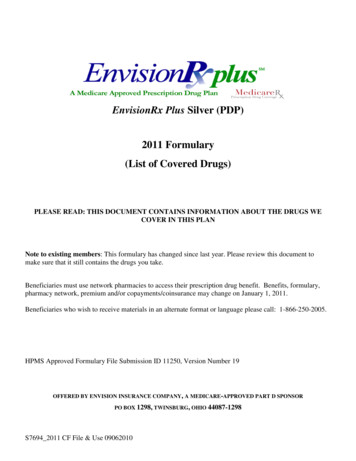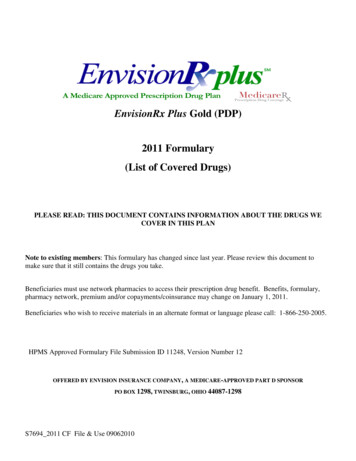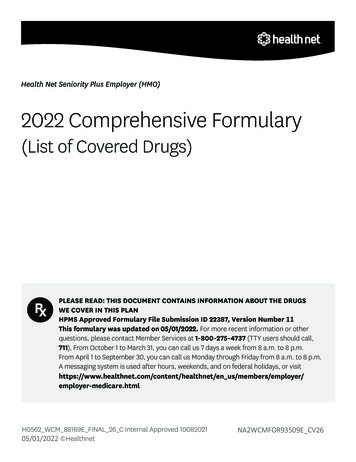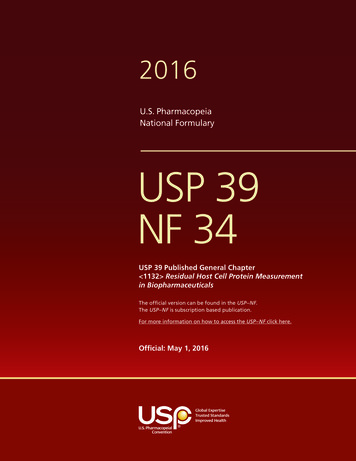
Transcription
2016U.S. PharmacopeiaNational FormularyUSP 39NF 34USP 39 Published General Chapter 1132 Residual Host Cell Protein Measurementin BiopharmaceuticalsThe official version can be found in the USP–NF.The USP–NF is subscription based publication.For more information on how to access the USP–NF click here.Official: May 1, 2016
2016USP 39THE UNITED STATES PHARMACOPEIANF 34THE NATIONAL FORMULARYVolume 1By authority of the United States Pharmacopeial ConventionPrepared by the Council of Experts and its Expert CommitteesOfficial from May 1, 2016The designation on the cover of this publication, “USP NF 2016,” is for ease ofidentification only. The publication contains two separate compendia: The UnitedStates Pharmacopeia, Thirty-Ninth Revision, and The National Formulary, Thirty-FourthEdition.THE UNITED STATES PHARMACOPEIAL CONVENTION12601 Twinbrook Parkway, Rockville, MD 20852
1416 á1130ñ Nucleic Acid-Based Techniques / General InformationUSP 39Although safety concerns regarding residual DNA impurities are not as prominent as they once were, the levels of residualDNA in any bioprocess remain a key quality attribute and help define the process.á1132ñ Residual Host Cell Protein Measurement in BiopharmaceuticalsGeneral Chapters1. INTRODUCTION AND SCOPEMany medicinal products are produced through recombinant technology via a host cell (e.g., bacteria, yeast, or mammalian, insect, or plant cell lines). During the manufacture of such products, some amount of non-product, host cell-derived material will inevitably be introduced into the process stream. This process results in a mixture of the desired product and host cellderived impurities, including host cell proteins (HCPs), and other process-related impurities that will be targeted for clearancethrough bioprocessing.Residual HCPs have the potential to affect product quality, safety, and efficacy; therefore, the quantity of HCPs should below. The product purification processes must be optimized to consistently remove as many HCPs as feasible, with the goal ofmaking the product as pure as possible.The primary concern with HCPs in biopharmaceutical products is their potential to induce anti-HCP antibodies that couldinduce a clinical effect in patients. In addition, HCPs may possibly act as adjuvants, which can induce anti-drug antibodies thatcan affect the safety or efficacy of the drug. A more extensive discussion of immunogenicity and its effect on preclinical andclinical studies is described in USP general chapter Immunogenicity Assays—Design and Validation of Immunoassays to Detect Anti-Drug Antibodies á1106ñ. HCPs can also have a direct effect on the quality of the product itself. For example, proteolytic HCPs,even in minute quantities, can cleave the desired protein product over time, reducing or eliminating biological potency or altering stability.This chapter focuses on HCP immunoassays for recombinant therapeutic products. It does not address products such as vaccines or gene-, cell-, or tissue-based therapies, although the general principles discussed may apply to the measurement ofHCPs in these products. The design and validation of immunoassays for HCPs involve unique and significant challenges due to:1) the wide variety of possible HCPs in medicinal products; 2) the general use of polyclonal antibody reagents to detect them;3) the lack of exactly matched standards for quantitation; 4) in some cases, a considerable effect from sample dilution effects;and 5) inherent limitations to measure single HCP species.The chapter includes assay development strategies throughout the product and process development lifecycle, and it describes approaches to demonstrate that the assay is fit for use (e.g., illustrates unit operation clearance of HCPs, lot release).Because of the complexity of HCP immunoassays, careful development and characterization of critical reagents are required,particularly for the immunogen used to elicit the anti-HCP antibodies, the antibody reagent(s), and the assay HCP standard.Because HCP testing is an essential part of process development and product quality control, HCP testing is also discussed inconjunction with regulatory requirements and other considerations for guidance on an overall control strategy for HCPs. Abrief outline of the general chapter follows:1. Introduction and Scope1.1 Considerations for Manufacturing, Characterization, and Consistency2. Terminology3. HCP Immunoassay Methods3.1 The Assay Development Cycle3.2 Development and Characterization of HCP Reagents3.3 Immunoassay Method Development and Qualifying as Fit for Use4. HCP Immunoassay Method Validation4.1 Accuracy4.2 Sensitivity and Assay Range4.3 Sample Linearity4.4 Specificity5. Supporting Technologies for Residual HCP Detection, Identification, and Measurement5.1 Considerations for Electrophoretic Methods5.2 Considerations for Western Blot Methods5.3 Considerations for Chromatographic and Proteomic Methods5.4 Concluding Remarks on Supporting Technologies for HCPs6. Use of HCP Immunoassays for Process Development, Characterization, and Validation6.1 Assays for Individual HCPs6.2. Control Strategy7. Summary and Conclusions8. Bibliography
General Information / á1132ñ Residual Host Cell Protein 1417USP 391.1 Considerations for Manufacturing, Characterization, and Consistency2. TERMINOLOGYTo help establish a common nomenclature in the literature and with regulatory agencies, Table 1 lists common terms withtheir definitions (indicating how they are used in this chapter) in addition to synonyms that have been used historically. Notethat the term “platform” indicates that the same set of standards and reagents is used within a company to test a variety ofproducts made from the same type of expression system (e.g., CHO cells) grown under similar upstream conditions. In thecase of platform HCP assays, the antibodies to HCP are obtained from animals immunized with HCP antigens generated from acommon upstream process that is applicable to many products, even if the downstream purifications are different. This approach allows the knowledge from prior products to be leveraged. Justification that an assay is suitable for a new product,using the same expression system and common upstream conditions, is therefore often relatively straightforward.The HCP immunogen used to generate platform anti-HCP antibodies and used often as the assay calibration standard is, bydesign, comprised of a broad set of HCPs. In contrast, the qualifier “process-specific” indicates that the immunogen/standardhas been prepared from a set of HCPs unique to a given process (either a unique upstream cell culture process or a uniquedownstream purification process). Process-specific assays are, therefore, limited in their utility, and each must be fully qualifiedfor each process. Process-specific immunogens and calibration standards are, by intent, more narrow and specific to a givenprocess. “Commercially available” assays produced by vendors are often derived from a combination of strains and harvest/purification procedures, and these assays are intended to have a broad application; but these commercially available assays arenot specifically designed for a given manufacturer’s proprietary cell line, and users do not have control over reagent availabilityand lot-to-lot consistency.Table 1. HCP-associated TerminologyTermDefinitionCommercially availableAvailable to the public for commercial sale; typically a combination of upstream isolatesand corresponding antibodies made by the vendor and sold as reagents or kits.aHistorical SynonymsGenericIn some cases, both purifications are performed, typically the protein A/G first, then the HCP affinity.Although ppm has been used historically, it is not advised because this term is used to reflect mass per unit volume for other types of tests. It is recognizedthat ng is used conventionally as a value derived from interpolation from an HCP standard curve (in units of ng/mL), where the signal is reflective of antibodybinding and, unlike the therapeutic protein concentration measurement, does not strictly reflect the mass of HCP that may be present.bGeneral ChaptersDifferent cell-based expression systems are used to manufacture medicinal products, such as bacteria (Escherichia coli, Pseudomonas fluorescens), yeast (Saccharomyces cerevisae, Pichia pastoris), mammalian cells (e.g., Chinese hamster ovary (CHO),mouse myeloma cell line NSO, and others), insect cells (baculovirus-infected Spodoptera frugiperda cells), and plant cells (tobacco, Arabidopsis, rice). The particular HCP profile is unique and specific to the particular host cells under specific culture conditions and manufacturing processes. HCPs can vary in pI ( 3–11) and hydrophobicity, and HCPs display a wide range of molecular weights (from 5 kDa to at least 250 kDa), depending on the host cell and manufacturing process used. The numberof HCPs in upstream samples can run anywhere from several hundred to more than one thousand proteins, depending on thehost cell and culture conditions. Although many cellular hosts have been used in biopharmaceutical manufacturing historically,the most experience has been gained using E. coli and the mammalian cells CHO, NSO, SP2/0, and human embryonic kidneycell line HEK293. The guidance in this chapter draws most heavily from the experience with these expression systems; however, general principles apply broadly to any host cell system.In mammalian cells, the recombinant protein is typically secreted from the cells into the cell culture fluid (CCF), along withmany of the HCPs. However, it has been observed that intracellular protein trafficking may not proceed in a normal fashion inproduction cultures. For example, proteins usually associated with intracellular organelles, such as lysosomes, may be found inthe CCF of largely viable cell cultures, because the clones have been selected for maximum protein export. In addition, assome of the cells die, their soluble, intracellular proteins are released into the CCF. Some harvest operations also lyse cells;therefore, the resulting harvested CCF typically contains both secreted and intracellular HCPs. While this mixture of proteinsincubates in the fermenter, additional changes in the HCP population may occur, for example, as the result of enzymatic activity (e.g., proteinases or sialidases).HCP assays provide important information about the composition of the material entering the downstream recovery processand how each purification step affects HCP clearance. In some cases, HCPs can even bind to, and co-purify with, certain products. Process characterization and validation studies are needed to show which process steps remove HCPs and also to demonstrate the robustness of these steps for consistently removing HCPs. As such, HCP assays are an essential part of purificationprocess development and help ensure manufacturing consistency. Lastly, reproducible and reliable HCP assays may be required to measure residual HCPs remaining in the drug substance (DS) used to make drug product (DP) that is delivered to thepatient. HCP levels should be measured in: 1) preclinical lots used in toxicology assessment, 2) all lots during clinical development, and 3) process validation samples from the final manufacturing process. After approval, HCP monitoring may be required as an element of the control system. Subsequent sections of this chapter discuss in more detail the use of HCP assays inprocess validation and in a good manufacturing practices (GMP) control system.
1418 á1132ñ Residual Host Cell Protein / General InformationUSP 39Table 1. HCP-associated Terminology (Continued)General ChaptersTermDefinitionHistorical SynonymsPlatformThe same set of an HCP standard and antibodies is developed with a company’s propriet- Custom, in-house, proprietaryary host cell strain and used broadly within a type (e.g., CHO) across several productswhen the upstream conditions are similar.UpstreamprocessspecificAn assay designed from material where the upstream culture process deviates significant- Custom, in-house, product-specific,ly from the platform.proprietaryThis is generally before any purification and may be applied to more than one product ifthese parameters are similar.DownstreamprocessspecificAn assay designed from materials where the downstream unit operations are used to enrich the HCP population.This may be applied to more than one product if these parameters are similar. This israrely used today and is not recommended except for certain products with exceptionaldownstream processing.Custom, in-house, product-specific,proprietaryAssay for anindividualHCPAn assay using a standard composed of an identified, single, known HCP and its specificantibody/antibodies.Single analyte assay or Custom,HCP-specificCoverageDescribes the assessment of how completely a population of polyclonal antibodies recognize the population of HCPs.The coverage assessment may be made on the HCP population used as the HCP antigenor from the product production culture.QualificationDemonstration of suitability of analytical methods (including reagents used in thesemethods) for their intended application to a given process and in-process samples.Protein A/G- Affinity purification of antibodies with immobilized Protein A or Gaaffinity purificationAffinity chromatographyHCP-affinitypurificationAffinity purification of antibodies using immobilized HCP (antigen)aAffinity chromatography, immunoaffinitychromatographyNull cellThe cell strain used for production that does not contain the product-specific genetic elements; includes untransfected parental cells and cells transfected with the expressionvector but without the product gene.Parental, blank, or mock-transfected cellng/mgThe numerical quantity (ratio) of HCP per product, where ng represents HCP mass andmg represents the product mass.It is calculated by dividing the HCP concentration (ng/mL) by the product protein concentration (mg/mL).ppmbaIn some cases, both purifications are performed, typically the protein A/G first, then the HCP affinity.Although ppm has been used historically, it is not advised because this term is used to reflect mass per unit volume for other types of tests. It is recognizedthat ng is used conventionally as a value derived from interpolation from an HCP standard curve (in units of ng/mL), where the signal is reflective of antibodybinding and, unlike the therapeutic protein concentration measurement, does not strictly reflect the mass of HCP that may be present.b3. HCP IMMUNOASSAY METHODSImmunoassay methods rely on antibodies that recognize, as broadly as possible, the population of HCPs entering the downstream purification process; therefore, the sandwich immunoassay, designed with polyclonal antibodies, is the workhorse ofHCP monitoring and quantitation. This assay format offers a combination of high sensitivity, specificity, throughput, automation potential, rapid turnaround, quantitative results, and low cost per assay that is unmatched by any other currently availableassay technology. Other immunoassay formats (e.g., competitive immunoassays) may or may not be suitable, because theylack either the specificity or the sensitivity afforded by the sandwich format. Although these methods result in a single HCPvalue for a given lot, the number can give greater weight to HCPs for which high-affinity antibodies are present in the reagent(s)—and no or low weight to HCPs which are either not recognized or recognized by low-affinity antibodies in the assay.For these reasons, orthogonal measures of product purity are often needed. More details on these methods can be found in 5.Supporting Technologies for Residual HCP Detection, Identification, and Measurement.The basic principles and design of immunoassays are discussed in USP chapter Immunological Test Methods—Enzyme-LinkedImmunosorbent Assay (ELISA) á1103ñ. The format that is most commonly used for HCP testing is the sandwich immunoassaywith detection systems such as colorimetric, electrochemiluminescent (ECL), chemiluminescent, radioactive, or others. Homogeneous immunoassays, including competitive assays, where all of the reagents are combined at once and the binding occursin a single step without washing, may be problematic due to antigen excess leading to antibody insufficiency issues (discussedlater in the chapter); therefore, these formats should be used with caution. The heterogeneous sandwich immunoassay formatdescribed in chapter á1103ñ is generally preferred, because the dynamic range and sensitivity may be reduced in the homogeneous format. The formats, with their advantages and disadvantages, are discussed further in chapter Immunological Test Methods—General Considerations á1102ñ. Data analysis is typically performed with a nonlinear fit of the sigmoidal curve generatedby a wide range of standard concentrations, although some analyses may focus on the low end of the curve for greater sensitivity.
USP 39General Information / á1132ñ Residual Host Cell Protein 14193.1 The Assay Development CycleFigure 1 illustrates common assay development plans, depending on the reagents available at various stages. Fewer bridgingstudies are required when: 1) platform reagents are available, and 2) upstream processes are historically consistent. Figure 1Aillustrates a scenario where platform methods are not available, and a commercially available assay is used up to the stage ofprocess validation with appropriate assay qualification. For phase III and beyond, either a platform or upstream, process-specific method is preferred. A bridging study should be performed to support assay replacement. If the commercial assay is intended for phase III and post-approval, care must be taken to fully demonstrate that the assay reagents are applicable to the process HCPs. An additional consideration is that the reagents are from an outside vendor over whom the biopharmaceutical manufacturer has less control.Figure 1B suggests that a platform assay can be used through all stages of product development if already available whenproduct development starts. The platform assay should be qualified for each new product. Switching to an upstream, processspecific assay may be necessary for phase III or process validation and beyond, if the cell culture process is significantlychanged from the platform process, and may introduce significantly different HCP populations. A bridging study should beperformed to support assay replacement.The limitations of a downstream-specific HCP assay should be considered, because it may be tempting to think that HCPassays are improved by taking the HCPs from null expression through the first column(s) and immunizing animals with adownstream column pool. Historically, the logic was that the immunogen and standard would be enriched in those HCPsmost likely to enter the recovery process and be in the final product. This strategy was based on the assumption that, ratherthan having thousands of irrelevant proteins in the immunogen, only those most likely to be in the process will be present inthe immunogen; thus, the resulting assay will be focused on those HCPs of greatest interest. Potential concerns that may ariseas a result of this approach are:1. If only HCPs from a null cell run pool from the first column are used, then later changes during process development(e.g., changes in column run conditions) could invalidate the HCP assay. Thus, process development becomes very restricted and involves the risk of needing to develop multiple HCP assays for slight process changes (or the need to manage the uncertainty).2. HCPs that co-purify with a product may do so because they bind directly or indirectly to the product protein. A null cellrun of a column without the product protein would miss these HCPs.3. Nonspecific adsorption to chromatography resins is not uncommon and, often, is not a reproducible phenomenon. Compared to the first passage, subsequent passage of the null cell run material over a column will likely produce a different setof HCPs after passage over a new column resin.3.2 Development and Characterization of HCP Reagents3.2.1 PREPARATION OF ANTIGEN/HCP STANDARDAs described in 1.1 Considerations for Manufacturing, Characterization, and Consistency, the total HCP “antigen” is a complexpopulation of proteins; therefore, when generating the HCP antigen/standard reagent, it is important to ensure that: 1) thecalibration standard is representative of the cell line and manufacturing process, 2) its protein concentration is accuratelyquantified, and 3) the immunogen is administered in a way that generates polyclonal antibodies with reactivity to as manydifferent HCPs as possible. The HCP antigen composition should also be comprehensive enough to tolerate normal processmanufacturing changes during the life cycle of the product(s).In addition to the uses above, the HCP antigen may also be needed to prepare the affinity column for purification of theantisera. If affinity purification is used, the quantity of HCP antigen needed should be carefully planned. The amount producedshould be large enough to provide sufficient inventory for many years (often 10–20 years); ideally, for the whole life span ofthe product. However, the antigen preparation process should be performed and documented in a way that facilitates a potential resupply.General ChaptersFigure 1A. If there is no platform assay before product development starts.Figure 1B. If there is a platform assay before product development starts.
1420 á1132ñ Residual Host Cell Protein / General InformationUSP 39Because the HCP assay is used to test DS samples that contain trace HCP impurities, any cross-reactivity of the anti-HCP antibodies with the product may compromise the test method and yield biased results. Therefore, any contamination of the HCPantigen with product must be avoided to prevent the generation of anti-product antibodies.3.2.1.1 Preparation of HCP antigen from mammalian cells: The majority of biopharmaceutical products produced todayare expressed in mammalian cells, e.g., CHO cells. A typical process for the preparation of CHO HCP antigen is outlined inFigure 2.General ChaptersFigure 2. Example of mammalian HCP antigen preparation.The first step is to establish a null cell that does not express the product gene, either by using non-transfected (i.e., parental)cells with a common origin to those used to make product alone, or to transfect them with the vector used to create the production cell line without the product coding gene (historically described as a “mock” transfection). The main advantage to thelatter is that selective markers (e.g., dihydrofolate reductase or glutamine synthetase) are expressed. Alternatively, antibodiescan be raised to selective markers independently. Another advantage is that mock-transfected null cells express selection markers and may be grown in cell culture conditions more closely resembling the manufacturing process. Using pools of mocktransfected null lines which have not been cloned allows for the maximum potential genetic diversity and therefore gives thehighest potential of generating a broad host cell protein population. However, these cultures, which are seeded with cell pools(not cloned), may demonstrate more variability from run to run. Both approaches [non-transfected (parental) and mock transfected] are commonly used. Both are also subject to the following issues: the cell culture process optimized for the productionclone may not lead to similar viability and cell density of the null cells. In addition, in the absence of the stresses experiencedby cells producing large quantities of product protein, the null cell lines may exhibit a different HCP profile. These changes inviability, cellular metabolism, and cell density may alter the HCP profile of the antigen, making it less representative of themanufacturing process. More about choosing appropriate HCP antigen preparation conditions is discussed below.Once the null cells have been established, the HCP antigen is prepared in a bioreactor, cell culture flask, or cell culture bagreflective of the product or process cell culture conditions. A platform cell culture process may be applied, which represents acommon manufacturing process for several products (e.g., CHO-derived monoclonal antibodies). Typically, the resulting HCPantigen is minimally processed to ensure a broad HCP spectrum, making the antigen suitable for HCP monitoring of multipleproducts generated from the platform process. A platform HCP antigen also may be produced by combining several null cellruns with slightly different cell culture conditions (e.g., allowing the culture to remain in the bioreactor for longer periods oftime to vary the cell viability). This approach is used to obtain a broader HCP spectrum, and antisera raised against this immunogen may be suitable for HCP detection in products generated from a variety of slightly different processes. These reagentsalso may increase the robustness of the HCP immunoassay toward process changes.Alternatively, the HCP antigen may be prepared using an upstream, process-specific approach in which the cell culture process is tailored to mimic the production process for a unique product or specific process. The advantage of this approach maybe the high relevance of the resulting HCP antigen to a particular upstream process. As with platform reagents, because noadditional processing purification steps are included, the antigen contains a broad range of HCPs, and the antigen will oftenremain suitable for HCP monitoring after downstream production-process changes. The disadvantage of this approach is thatthe use of the reagents typically will be limited to a single (or few) product(s) or process(es).The HCP antigen can be produced from a representative small scale, pilot scale, or production scale run. There are pros andcons for each approach. Pilot or production scale may mimic the actual process best; however, normal variation between cellculture runs may not be reflected if only one run at large scale is applied. Conversely, several small-scale preparations can bepooled and may better reflect the run-to-run variability of the cell culture process. Regardless of the scale, the presence ofproduct should be aggressively avoided, because its presence in the HCP immunogen will compromise the quality of the resulting immunoassay antisera.After performing the null cell run, the HCP antigen can be prepared from the cell lysate, the concentrated CCF, or as a mixture of both as shown in Figure 2. If the antigen is prepared from CCF, the cells may be harvested at a time when productionline harvest is performed or some days later, to allow for some of the cells to lyse and release HCPs into CCF and therebybroaden the HCP spectrum.To prepare immunogen from cell lysate, the cells are harvested by centrifugation, and the cell pellets are washed and lysed(e.g., by using repeated cycles of freeze/thaw, or high pressure homogenization). Conditions are typically selected to mimicthe production process (i.e., to prepare immunogen from CCF, cells and debris are removed by centrifugation, and the CCF is
USP 39General Information / á1132ñ Residual Host Cell Protein 1421General Chaptersthen treated by ultrafiltration/diafiltration). The buffer is exchanged (e.g., into PBS or HEPES), and the CCF is concentrated.The cut-off for filtration should be chosen to minimize loss of HCP, e.g., 10 kDa or less.3.2.1.2 Preparation of HCP antigen from bacterial cells: Many of the above-described principles used in the preparation ofmammalian HCP antigens also apply to prokaryotic cell culture. However, some unique challenges should be considered. Inparticular, manufacturing processes for bacterial expression system come in more varieties, such as those yielding concentrated protein deposits known as inclusion bodies, which can represent up to 95% of the total cell protein. HCP impurities arealso present in the inclusion bodies, including bacterial membrane proteins, ribosomal subunit proteins, and cytoplasmic proteins, such as small heat shock proteins or chaperones. The formation of inclusion bodies in the production strain makes itmore difficult to generate a representative HCP preparation from a null cell fermentation process. The null cell may not havethe same HCP profile, and it will not generate inclusion bodies with which specific HCPs may co-purify, as described above. Inother cases, HCPs have been created from periplasmic secretion systems, if the production process can be replicated in the nullcell.Because there is no obvious approach for overcoming these limitations, in practice the bacterial HCP antigen is usually generated from the lysates of washed cells, using null cell fermentations, that are grown and induced under conditions representing the upstream manufacturing process as closely as possible. As for any HCP antigen, it is necessary to demonstrate that theHCP profile is representative of the manufacturing process before use in assay development. This approach yields the full complement of HCPs expressed and hence is very broad.Because most animals have been exposed to bacterial antigens and may have pre-existing antibodies to many bacterial cellproteins, it is important to characterize the pre-existing antibody responses, and if appropriate, consider the use of specificpathogen-free (SPF) animals. The presence of significant levels of pre-existing anti-HCP antibodies may confound the analysisof the antibody responses; therefore, it is important to screen preimmune sera from animals for pre-existing antibodies prior toimmunization.Null bacterial cells transfected with the expression vector contain chaperone genes that may be expressed at high levels(e.g., 5% of the total HCPs). Such overexpression of particular HCP impurities might necessitate the development of singleanalyte assays for these particul
The designation on the cover of this publication, "USP NF 2016," is for ease of identification only. The publication contains two separate compendia: The United States Pharmacopeia, Thirty-Ninth Revision, and The National Formulary, Thirty-Fourth Edition. THE UNITED STATES PHARMACOPEIAL CONVENTION 12601 Twinbrook Parkway, Rockville, MD 20852
